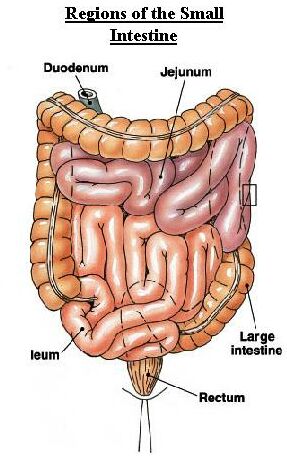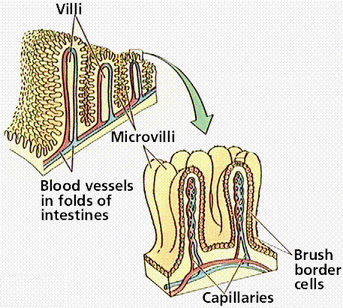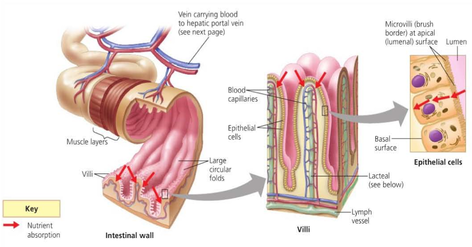
Everyone is aware that the food we eat gives us energy and helps us remain fit and strong. We are advised to follow a specific diet in order to avoid contracting the diseases and other disorders. What is it that makes the food transform itself into the energy that we require? The food that we eat enters the blood and it is the ‘Small Intestine’ that forms the longest part of the digestive tract. What we eat, about 90 percent of it is assimilated in the blood through the Small Intestine. The Small Intestine holds the food that we eat for about four hours and then gets digested. Generally, it is three times the length of the body and the movements of the body are not seen although, we can experience a painful sensation when we eat too much.
Small Intestine is a 5 m long narrow tube in the digestive system, located in the abdomen. Held in place by the tissues, it is attached to the abdominal wall and is divided into three sections:
-
The duodenum digests the food from the stomach and is a receiving area for the chemicals
-
Most of the nutrients that are absorbed in the blood are in the jejunum
-
It is in the ileum where the remaining nutrients are absorbed before moving into the large intestine

On an average, the Small Intestine measures about 18–20 feet in an average adult, which makes it four times the height of a normal individual. A three-part tube, it is about one and a half to two inches in diameter. The finger-like projections that increase the surface area for absorbing the nutrients is lined in the Small Intestine with the villi. Each villus has microscopic microvilli, which brings in fresh and oxygenated blood and releases nutrient-enriched blood. The villi stir up the liquefied food and pass the absorbed food into the blood and the lymph vessels. The lymph vessels get the fatty nutrients and the glucose and the amino acids transfers to the blood and the liver. The muscles churn the food and mix it with the gastric juices. The Small Intestine makes efforts to move the food forward so that the nutrients can be absorbed.

About 90 percent of the digestion and absorption of food occurs in the Small Intestine and the remaining 10 percent in the stomach and the large intestine. The two distinct parts of digestion are the mechanical digestion which involves activities like chewing, grinding, churning, etc and the other is the chemical digestion which involves the enzyme, the bile acids, etc. however the main function of the Small Intestine is to absorb the nutrients and minerals from the food. The other substances in the Small Intestine include:
-
Water: Osmosis absorbs most of the water in the ingested food and beverages, out of which, about 80 percent is absorbed by the Small Intestine.
-
Electrolytes: Electrolytes absorb the sodium by diffusion and active transport.
-
Vitamins and Minerals: The fat soluble vitamins include Vitamins A, D, E and K. They are absorbed together with dietary fats. On the other hand, water-soluble vitamins, namely, vitamins B and C are absorbed by diffusion.

Though a complex organ, certain possible conditions may affect the functioning of the Small Intestine:
Obstructive disorders of the Small Intestine: These include:
-
Paralytic Ileus: It is generally a mechanical obstruction of the gastrointestinal tract
-
Volvulus: It is usually found in infants and is an obstruction of the loop of bowel, the nose of which is twisted around its site
-
Hernia: It is a layer of the fibrous tissue of an organ through the wall of the cavity
-
Adhesions: They form a band between the tissues and the organs and are usually a result of an injury during the surgery
Infectious Diseases: These are transmissible and easily communicable diseases, resulting in infection and the growth of pathogens in the body of an individual. The infectious diseases in the Small Intestine include:
-
Giardiasis: Popularly known as the beaver fever, it is a parasitic disease caused by the flagellate protozoan
-
Ascariasis: It is a disease caused by the parasitic roundworm known as lumbricoides and is found in areas where the hygiene is poor
-
Tropical Sprue: It is marked with abnormal flattering of the villi and the inflammation of the Small Intestine
-
Tape worm
-
Hook worm
Bacterial Infections: The bacterial infections involve:
-
Enterotoxigenic
-
Salmonella enteric: It is a rod shaped flagellate bacterium caused due to intake of infected food
-
Campylobacter: They are twisted bacteria with either a unipolar or bipolar flagella and the organisms have a spiral appearance
-
Shigella: It is a non-motile and rod-shaped bacteria closely related to the Salmonella
Neoplasms (Cancers):
-
Adenocarcinoma: It is a cancer that originates in the glandular tissue and is not limited to the surface layer of the skin and the glands
-
Carcinoid: It is a slow growing, neuroendocrine tumour that originates in the neuroendocrine system
-
Gastrointestinal Stromal Tumour: They are the most common tumours of the gastrointestinal tract in the connective tissues
-
Lymphoma: It is that type of blood cancer that occurs when B or T lymphocytes divide faster than the normal pace. It may develop in the lymph nodes, spleen and the bone marrow.


